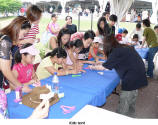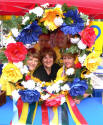
Dick reports...

Street Festivals
It appears that street festivals have taken over the city of Toronto. Nearly every community jumped on the bandwagon. The Festival of South Asia and was celebrated on Gerard Street East – in Toronto – between Greenwood and Coxwell Ave. This area has a predominantly ‘East Indian’ flavour and offers a rare opportunity for a concentrated and deeper than usual immersion into part of Toronto’s cultural mosaic.
The festival district was amazingly clean. Most of the stores even washed down the sidewalks – something I remember only from Germany! Many restaurants and stores had set up operations outdoors. Prices were held very reasonable. For example, beautiful shoes were $5.99 or two for $10.00 in one store. Typical South Asian fashions were displayed on the sidewalks in front of the many fashion stores and attended by sales staffs that were dressed matching the displays. It was a symphony of colours.
Wonderful décor was offered for sale, like small temples, and elephants and gods in all shapes and sizes.
There was a rich variety of typical South Asian food available from out-door kiosks and local restaurants with colourful names like Ali Baba, filling the air with exotic aromas. This truly was an ideal opportunity to try culinary varieties from South Asia. If you missed it you can still go there throughout the year and enjoy the multitude flavours and colours of what we perhaps can call Little India.
 At
the Harbourfront Centre the Ho-Hai-Yan Taiwan Festival took centre stage:
Cooking demos by a Taiwanese chef, various magnificent dance performances
and a youth orchestra – the Ho-Deng Ch
At
the Harbourfront Centre the Ho-Hai-Yan Taiwan Festival took centre stage:
Cooking demos by a Taiwanese chef, various magnificent dance performances
and a youth orchestra – the Ho-Deng Ch inese
Music Ensemble - playing Chinese type music in some strange looking
traditional Chinese instruments. It did not sound all that strange to my
European ears.
inese
Music Ensemble - playing Chinese type music in some strange looking
traditional Chinese instruments. It did not sound all that strange to my
European ears.
Some of the dancer’s costumes – of the Ho-Hai-Yan festival
by the Zu-Yun Cultural Music and Dance Troupe - were
 spectacularly
intricate and vibrant. One other group – mostly women - demonstrated
drumming on huge drums. It was quite well done and vigorously applauded by
an appreciative audience at the concert stage.
spectacularly
intricate and vibrant. One other group – mostly women - demonstrated
drumming on huge drums. It was quite well done and vigorously applauded by
an appreciative audience at the concert stage.
 For
the children present, Master Hung Hsin-Fu demonstrated the ‘Aria of Paper’
sculpting in the Kid’s Tent. The kids were fascinated and some were quite
skilful in their endeavours.
For
the children present, Master Hung Hsin-Fu demonstrated the ‘Aria of Paper’
sculpting in the Kid’s Tent. The kids were fascinated and some were quite
skilful in their endeavours.
Wonderful pottery, sculptures, woodcarvings and paper-art could be viewed – and admired - in the Brigantine Room, all day. It was one of the most crowded areas of the whole show since most of it was so wonderfully elaborate and complex that people had to spend more time viewing the exhibits.
Bloor Village goes Ukrainian
 This
year marks the 10th annual anniversary of this magnificent
display of Ukrainian traditions, customs and culture – bigger than ever
before. The Ukrainian Festival started on Friday evening with a ‘Grand Stage
Show’ and performances by Ukrainian artists – dancers, musicians and bands
and ended with a Street ‘Zabava’ – a street dance – late at night. This
evening also featured the CD launch of the famous Pid Oblachkom vocal
quartet from Toronto that entertained with traditional and romantic songs
from the Ukraine.
This
year marks the 10th annual anniversary of this magnificent
display of Ukrainian traditions, customs and culture – bigger than ever
before. The Ukrainian Festival started on Friday evening with a ‘Grand Stage
Show’ and performances by Ukrainian artists – dancers, musicians and bands
and ended with a Street ‘Zabava’ – a street dance – late at night. This
evening also featured the CD launch of the famous Pid Oblachkom vocal
quartet from Toronto that entertained with traditional and romantic songs
from the Ukraine.
 Saturday
morning began with a parade – led by Parade Marshal Senator Raynell
Andreychuk - that started at High Park and ended at Jane Street with
thousands of visitors lining the street to watch the marching bands and many
ethnic cultural associations passing by.
Saturday
morning began with a parade – led by Parade Marshal Senator Raynell
Andreychuk - that started at High Park and ended at Jane Street with
thousands of visitors lining the street to watch the marching bands and many
ethnic cultural associations passing by.
Parade Scenes
|
|
|
|
|
|
Something that was very obvious and hard to ignore was the fact that a great many youngsters – in a multitude of diverse groups – were included in this multicultural demonstration. They were very proud to wear their traditional colourful Ukrainian dress and most of them still spoke Ukrainian and were proud of their heritage!
 The
opening ceremonies at the main stage - opened by the Vanguard Band from
Mississauga - started after the parade, and featured dignitaries from
politics and business addressing and congratulating the Ukrainian Community
for their endeavours. Some were very touching and sincere including
The
opening ceremonies at the main stage - opened by the Vanguard Band from
Mississauga - started after the parade, and featured dignitaries from
politics and business addressing and congratulating the Ukrainian Community
for their endeavours. Some were very touching and sincere including spiritual good wishes from a First Nations representative chief.
spiritual good wishes from a First Nations representative chief.
The imposing ceremony, was interspersed with dances by the Vatra Dance Ensemble and followed by a vocal performance of the ‘Chornomor Kozaky’, a group of real ‘Cossacks’ imported from Odessa on the Black Sea, for this occasion.
 They
were dressed head to toe in traditional 17th century regalia,
complete with ‘sharovary’ (wide satin trousers), handlebar moustaches and
military style cloaks. They fascinated the audience with singing patriotic
and battle songs that typified the Ukrainian Cossack image. But they were
not the only attraction at this festival. Dance ensembles, vocalists,
bandura players and many other gifted and talented artists strove to keep
the visitors entertained.
They
were dressed head to toe in traditional 17th century regalia,
complete with ‘sharovary’ (wide satin trousers), handlebar moustaches and
military style cloaks. They fascinated the audience with singing patriotic
and battle songs that typified the Ukrainian Cossack image. But they were
not the only attraction at this festival. Dance ensembles, vocalists,
bandura players and many other gifted and talented artists strove to keep
the visitors entertained.
 The
purpose of this festival is to offer the largest celebration of Ukrainian
spirit to the world – showcasing the best of Ukrainian art and culture by
providing an entertainment experience for the whole family, introducing
their culture to the general public and creating a tourist attraction that
benefits the Bloor West Village.
The
purpose of this festival is to offer the largest celebration of Ukrainian
spirit to the world – showcasing the best of Ukrainian art and culture by
providing an entertainment experience for the whole family, introducing
their culture to the general public and creating a tourist attraction that
benefits the Bloor West Village.
 Some
of the food served were the traditional Ukrainian fares such as Kobasky
sausages, Perogies (Varenyky), braised cabbage (Kabusta), cabbage rolls (Holubtsi),
Patichok and other culinary delicacies.
Some
of the food served were the traditional Ukrainian fares such as Kobasky
sausages, Perogies (Varenyky), braised cabbage (Kabusta), cabbage rolls (Holubtsi),
Patichok and other culinary delicacies.
The thirsty visitor had his choice of very tasty beers, such as Slavutich or Lvivske - or appetizing vodkas and Krimsekt from the Ukraine - in the bar-tents along the way.
The many vendors allowed the visitors to soak up some of the rich culture and heritage if the Ukrainian community. There were the traditional dolls-in-dolls, painted eggs, ceramic creations and wonderful pottery, paintings and handcrafts – especially at the Ukie Store booth.
This year a literary pavilion was added that also featured the new ‘Kobzar Children’s Anthology’ – a century of untold Ukrainian stories, edited by Marsha Forchuk Skrypuch.
The Kobzars were the blind minstrels of the Ukraine who memorized the epic poems and stories of hundreds of generations. Travelling around the country, they stopped in towns and villages along the way, where they told their tales and were welcomed by all.
‘Kobzar’s Children’ is more than a collection; it is a moving social document that honours the tradition of the Kobzars and revives memories once deliberately forgotten.
 Also,
with the children in mind, there was a small midway type area at the south
end of the festival that caters to the younger crowd and includes games of
skill, a ferries wheel, carrousel and similar suitable entertainment.
Also,
with the children in mind, there was a small midway type area at the south
end of the festival that caters to the younger crowd and includes games of
skill, a ferries wheel, carrousel and similar suitable entertainment.
There was a much relevant Ukrainian experience available giving the feeling that one is visiting the Ukraine itself – without leaving Toronto.
I think that these street festivals are a grand and much more effective replacement of the Caravan experience, which has run its course.
As always
Dick Altermann
Comments to: dick@echoworld.com














